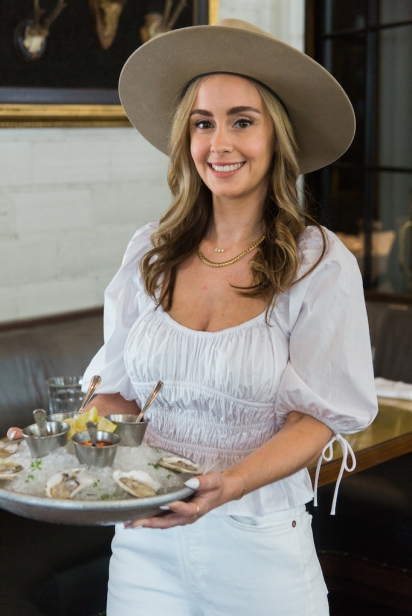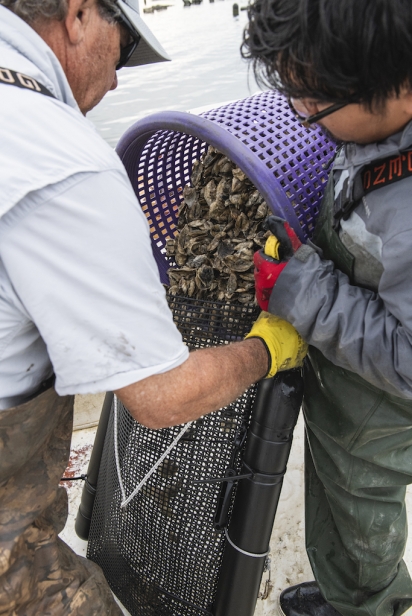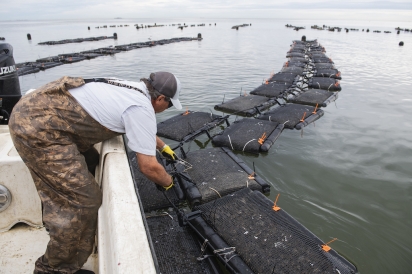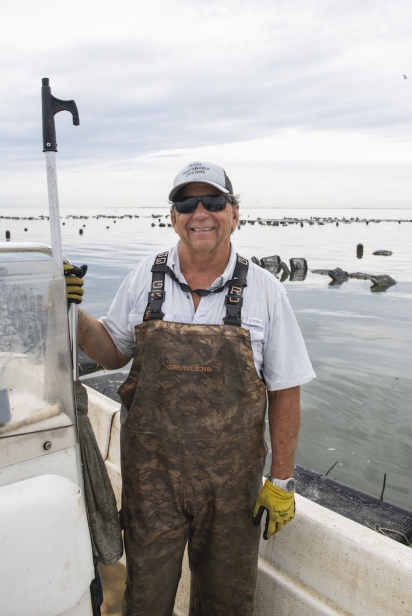Making Waves
Texas oyster lovers, rejoice! There’s a new day dawning on the Gulf Coast. From Galveston to Corpus Christi, newly permitted oyster farms (sometimes called “ranches” in time honored Texas fashion) are springing up along the coast. As they become established and productive, they will provide more of these tasty bivalves for Texas tables and oyster bars, supplementing the traditionally harvested oysters dredged from the bottom of local bays.
From Maritime Canada to the Gulf of Mexico, Crassostrea virginica (Eastern oyster) is the American native species that thrives in areas where saltwater and freshwater converge — marshes, estuaries and bays. For millennia, they’ve provided nourishment to Atlantic and Gulf coastal inhabitants. In Texas, Indigenous Karankawa and Atakapa peoples left mounds of oyster shells that remain to this day. These same oysters are now being raised on Texas oyster farms.
While farming oysters — or oyster mariculture — is just getting started in Texas, it’s hardly a new concept. It was practiced in China in the fourth century B.C.E. Ancient Romans enjoyed oysters so much that they established farms in British waters to supply Roman banquet tables. Modern oyster cultivation methods evolved in Europe and the U.S. in the 19th century as natural oyster beds became depleted from over-harvesting and pollution. Today, according to Monterey Bay Seafood Watch, farmed oysters account for approximately 95 percent of oyster consumed in the world.
Hannah Kaplan, co-founder and vice-president of Barrier Beauties on Galveston Bay, is an unlikely pioneer in Texas oyster farming. Her background is in hospitality and commercial real estate and, having grown up in a kosher household, she’d never eaten an oyster until Barrier Beauties’ first harvest in 2022. During the pandemic, she and her father, Houston businessman Joe Kaplan, became interested in opening a newly legal sustainable oyster farm on the Texas coast. They spent six months visiting farms and hatcheries in other parts of the country, researching methods and equipment, and learning the state’s requirements and regulations. In 2021, having leased a suitable location and fulfilled the complex application requirements, Barrier Beauties was granted the second permit to farm oysters in the state.
“I’ve always wanted my own business, and the sustainability factor of farmed oysters was an important consideration for me,” Kaplan says. “Finding the right location is critical, and the conditions on our farm are perfect. Our oysters are very happy there.” In the summer of 2023, Barrier Beauties “planted” 1.6 million baby oysters, which should take 7–10 months to mature.
Although oyster farms are well established in Florida, Mississippi, Alabama and Louisiana, Texas was the last Gulf Coast state to sanction oyster mariculture. In 2019, the Texas Legislature unanimously passed House Bill 1300 to legalize it. The new law granted the Texas Parks and Wildlife Department (TPWD) authority to develop and regulate a program. Legislators were persuaded by the efforts of various interested groups, including marine researchers who emphasized the need to augment the declining wild oyster population and improve coastal ecology. (It didn’t hurt the cause that funds from the BP Deepwater Horizon settlement were available.)
TPWD also regulates the commercial oyster fishery that harvests from seabeds along the coast. This once thriving industry has taken serious hits from hurricanes, droughts and industrial pollution, and yields have declined steadily as demand increases. In recent years, TPWD has regularly closed oyster beds to allow the reefs — important components of marine health — to rejuvenate, rebuild and recover from weather incidents.
Dr. Joe Fox, formerly of Texas A&M University-Corpus Christi and now the executive director of the Palacios Marine Agricultural Research Institute (PMARI), is widely considered the father of Texas oyster mariculture. He was instrumental in getting the 2019 legislation passed. “A healthy aquaculture industry takes pressure off the commercial fishery, conserving reefs, creating new jobs and adding to the coastal economy,” says Fox. “At the same time, oysters on the ranches are filtering water that improves ecosystem health and creating fish habitat. Everyone wins if they are successful.”
To aid that success, PMARI is establishing a Texas hatchery in Palacios. Hatcheries are controlled oyster breeding operations where adult oysters, or broodstock, spawn to produce millions of eggs that grow into larvae and then into the juvenile seed oysters that will be raised on the farms. Up to this time, Texas farmers needed to transport their broodstock to hatcheries in Alabama or Mississippi and then bring the babies back to grow to maturity in their native waters. Farmed oysters are typically bred to be sterile, which means that their energy is spent, not on reproduction, but on growing larger and faster. Texas oysters must be a minimum of 2.5 inches to be legally harvested, and farmed oysters can reach this size in as little as seven months.
Wild or cultivated, oysters feed on phytoplankton or algae suspended in the water. They open and close hinged shells, filtering food from the water passing through their gills. They play a critical role in the ecology of their surrounding waters. As it feeds, a single oyster can clean up to 50 gallons of sea water a day. Unlike other seafood farming operations, oysters are not fed through human intervention; they eat the same food and in the same way that wild oysters do.
Obtaining an oyster farm permit is somewhat arduous. While TPWD issues the permit, it must also be approved by the Texas Commission on Environmental Quality, the Texas General Land Office, the U.S. Coast Guard, and in some cases, the Army Corps of Engineers. The regulations include a farm’s minimum distance from sea grass and wild oyster beds and use of only locally sourced broodstock and approved equipment. Although extensive, the stringent regulations are designed to avoid genetic contamination and to maintain the highest standards of marine ecology.
The first Texas oyster farmer to obtain a permit was Brad Lomax, owner of the Water Street Oyster Bar in Corpus Christi, who was very involved in getting House Bill 1300 passed. In honor of that G-0001 permit, the oysters from his Texas Oyster Ranch on Copano Bay are called Copano Unos. David Aparicio of DJ’s Oyster Company near Palacios earned the third permit. His oysters are called Matagorda Pearls. Currently, there are 13 Texas oyster farms that are fully or conditionally permitted, ranging in size from two to 30 acres.
The Barrier Beauties oyster farm floats at the surface of Galveston Bay about seven nautical miles from Bolivar Peninsula. Picture a seven acre grid of posts and wires, with rows of attached bulky mesh bags that contain growing oysters. This is one of the approved methods for raising off-bottom oysters. Almost daily, general manager Gordon Lipscomb and a handful of employees go out in a bay boat, maneuver among the floating bags and perform the hard physical work required to maintain oyster health and well-being. They regularly lift the 50- to 80-pound bags into the boat, clean the bags, inspect the oysters and divide them into additional bags so they’ll have room to grow.
“These are animals, this is the ocean, conditions change, and you can control only so much,” says Lipscomb. “You need to be out there every day, keeping a close eye on things and making adjustments as needed.” At least twice during their lives, the oysters are hauled back to the company’s boat dock, where they are tumbled in a rotating contraption that rounds out their rough edges, promoting more uniform size and development of a deeper cup (the bottom shell).
As wine is defined by its terroir, oysters have merroir. The environment where oysters are raised is what primarily differentiates their various qualities. The mineral and salt content of the water, available food, and water temperatures all affect taste and texture.
Traditionally, oysters are named for the place where they grow — like Malpeques from Prince Edward Island or Murder Points from Alabama — with each locale providing a distinctive flavor profile. Texas wild oyster reefs have identifying names, but in recent times, this naming convention hasn’t been used much for Texas oysters. That’s changing as Copano Unos, Matagorda Pearls and Barrier Beauties identify their farmed locations. As more farms continue to develop and begin harvesting, there will be more named oysters from coastal locations.
In early 2023, Carol Huntsberger, owner of Austin-based Quality Seafood restaurant and wholesale operation, hosted a tasting of farmed oysters for Austin restaurateurs and food professionals. Brad Lomax, Hannah Kaplan and David Aparicio were there to introduce their oysters and talk about the new mariculture industry in Texas. “People could definitely discern taste differences among the oysters from the different farms,” Huntsberger says. “This industry is in its infancy, and it’s exciting to be involved at the ground level of something so brand new. Quality Seafood has a goal to support the Texas economy and this is one way we can do that.”
Chris TenEyck, chief culinary officer of Jack Allen’s Kitchen and Salt Traders Coastal Cooking in Austin and Round Rock, has been an early supporter of Texas oyster mariculture and is enthusiastic about their future gastronomic possibilities. “How cool will it be a few years down the line when you can order a flight of Texas oysters and compare them, knowing by their names what farm on what part of the coast they come from?” he says. “It’s going to take time, but we are so looking forward to this; oyster farmers are sitting on a goldmine, something really special. We’re excited to be a part of it, and we want to help customers learn about farmed oysters on our coast.”
So, oyster lovers of Texas, start looking for farmed oysters on restaurant menus near you. As you enjoy their distinct merroir, also appreciate the dedicated hard work that brings them to your table and remember the role oysters play in maintaining the health of Texas’ coastal waters.










